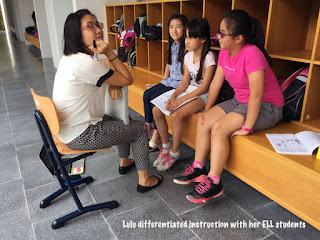Learn from Coaching Styles
I will be perfectly honest: my time in Lulu’s classroom was not a victory lap by any means. It was not a complete checkmate either. They were some failures in a sense that I have recently begun to love: First Attempt In Learning. They were also some victories. I consider this first attempt a great learning success.
I co-taught a lesson with Lulu to kick start her students presentation on Cultural Fridays. Lulu’s outcomes for this project are to raise her students awareness of other cultures in a fun, entertaining way, and to use technology to help each group work collaboratively.
At the end of the class, Lulu mentioned briefly how delighted she had been with the students sharing within their group. I am very curious to hear the rest of Lulu’s feedback during our post-lesson meeting.
This post belongs to a series of posts I originally published for my course on Eduro, Coaching: from Theory to Practice taught by Kim Cofino.
I co-taught a lesson with Lulu to kick start her students presentation on Cultural Fridays. Lulu’s outcomes for this project are to raise her students awareness of other cultures in a fun, entertaining way, and to use technology to help each group work collaboratively.
Lesson Planning
When we prepared this lesson, Lulu wanted me to start by showing the students how to change their school issued password. She mentioned they had unsuccessfully tried before and this is where I made my first and largest mistake: I was so eager to get to the good stuff, the presentation, that I said yes without asking any question. We set aside 10 min. for this (5 min. to talk about creating passwords and 5 min. for the procedure), it took 30 min of class time. I was so eager to listen to Lulu’s lesson plan, I forgot to explain my part of the co-teaching.IRL
In class, I ran into a wall which took a while to climb over. First the students had already heard the tips about passwords two weeks prior; and second, even when following my instructions, they could not change their password. The issue was system wide. To make matters worse, I had come with no visual of the steps and had to give all instructions orally, a massive waste of time. I learned that with co-teaching in coaching, we need to be exactly on the same page. Sharing a Google Doc of our lesson plan identifying the to-do list for each teacher is an excellent start. Education Week’s article Eight Tips For Making the Most of Co-Teaching includes other great tips for co-teaching in a special need environment that I feel also apply to our coaching methods.Victory
The main victory was a lesson stemming from all the positive feedback in this community. During our planning, we selected Google Sheets to create the collaborative presentation. Lulu is not very agile with the app and she was hoping that I could teach the kids how to use the app. Instead, I yielded that task to the students themselves. Following the examples shared in Eduro, I suggested the sandboxing method. This was a new strategy for Lulu and she was keen to try it. Under her direct instructions, the students took a few minutes to test Sheets and soon they were sharing three different ways to add photos to their slides (two of them I did not know worked on Chromebooks). Thank you Jocelyn for mentioning it and for the rest of you for highlighting how great this technique is. It worked very well! One more positive aspect of this activity is that it allows Lulu to differentiate instruction with her ELL students in a separate group as you can see in these photos. A lesson I took from sandboxing is that even with two teachers in the classroom, it is much more effective to let the students’ curiosity run free so they can discover on their own and learn from one another.Resources
I do have another resource I would like to share here. It is the visual I created for Lulu to provide guidance to her students. Another goal I had during this intervention was to uncover the possibilities of what I consider one of the best kept secret apps in the Google Apps list: Google Drawing. Lulu’s interest grew when she realized that this is the same app that powers the teacher portal. The app allows to add hyperlinks to a graphic which can be embedded with the working links on a site. In fact, I use Drawing extensively to create presentations, graphics, posters, interactive infographics, etc.At the end of the class, Lulu mentioned briefly how delighted she had been with the students sharing within their group. I am very curious to hear the rest of Lulu’s feedback during our post-lesson meeting.
This post belongs to a series of posts I originally published for my course on Eduro, Coaching: from Theory to Practice taught by Kim Cofino.
ASSIGNMENT - Observe a lesson with the colleague you have identified earlier. Share your experiences through a thoughtful reflection, including a summary of the lesson with key elements, strategies for coaching techniques you could (or did) use, ideas or suggestions for improving student learning.






Comments
Post a Comment